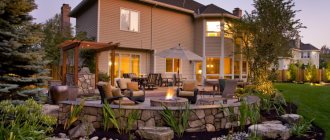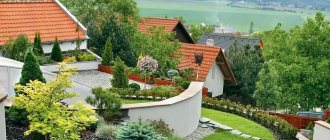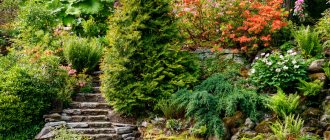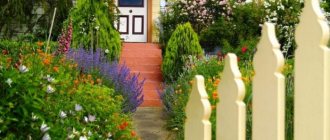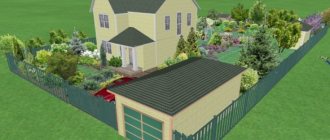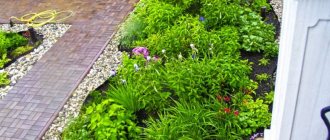Advantages and disadvantages of a site on a slope
Before you start arranging a vegetable garden on a site located on a slope, it is worth assessing all its advantages and disadvantages.
Among the positive factors of this arrangement are the following:
- such a site, if properly designed, will acquire a unique individuality;
- there is a great opportunity to design alpine slides and waterfalls;
- the site is clearly visible from the house, especially if it is located at the highest point;
- on a flat area, water never stagnates;
- the southern slope will allow you to grow any crops, even those that are particularly demanding on lighting.
The main disadvantages include larger monetary investments, in contrast to flat terrain. When planning a site, you need to pay attention to the following points:
- since water will constantly drain without lingering in the soil, you will need to water the plants more often;
- You should not locate residential buildings in the lower part of the site in order to avoid flooding;
- the possibility of landslides should be eliminated by additionally strengthening the area;
- the northern slope practically deprives cultivated plants of a chance to survive due to lack of light.
Alpine slide
This element of landscape design traditionally rises above the site and when arranging an alpine hill, it is usually necessary to make an embankment. So why not use a natural slope, which will be an ideal location for such a “stone flowerbed”.
To create an alpine slide, flowers are used that feel good on rocky soil and slopes and strengthen the ground. This arrangement will allow you to emphasize the “rocky flowerbed”, highlighting it from the surrounding space
How to arrange a vegetable garden on a slope
With the right approach, even on uneven terrain with a slope of more than 15%, you can set up a vegetable garden. The most suitable solution to the problem is to divide the area into terraces and pre-strengthen them.
To do this, determine the difference in heights and divide by the size of the horizontal base. Next, the area is divided into strips of a certain size. Gradually, starting from the top point, terraces are formed. The cut earth is lowered to the lower level and used to form a platform. Terraces are arranged either in a checkerboard pattern or using asymmetry.
To avoid soil sliding, the terraces are additionally reinforced with retaining walls. Metal and reinforced concrete are used for their manufacture. Wooden walls look beautiful, however, they are not so durable. It is relatively inexpensive to create retaining walls made of stone. A cement solution is used to fasten individual stones together. This design will last for more than one year.
In addition, drainage pipes will need to be installed on the site, through which water after rain will flow from the upper terrace to the lower levels.
Garden plants are planted either inside the retaining wall of the terrace (where nutritious soil is first poured) or placed in boxes.
The beds should not be placed on the lowest terrace. For the vegetable garden, you should choose a higher area, illuminated by the sun and without drafts.
To strengthen the slopes, shrubs with a strong root system are planted, such as rose hips, lilacs, sea buckthorn, and Japanese quince. Planted as a hedge, such plants will also serve as protection from the wind.
steps
Convenient movement is the key to a comfortable stay. When planning a site on a slope, much attention is paid to stairs. They must be safe with a width of half a meter and a height of 10 cm. The long climb is broken up by island spans in places where the direction of movement changes. The installation of sculptures, flowerpots and flowerbed equipment is appropriate here. The material of the stair steps is:
- Wood.
- Logs.
- Paving slabs.
- Cobblestones.
The main condition is the roughness of the coating, which prevents slipping.
The ramp will provide unimpeded passage for garden carts.
What is the best way to arrange flower beds on a slope?
The very gentle slope of the site does not at all interfere with growing plants, be they trees, shrubs or herbaceous crops, not to mention weeds. Therefore, if the area you are landscaping smoothly descends from the house (or rises up) at an angle within 10 degrees, you can safely plant as if it were on an ideal plane. Sloping plants will even be easier to water because water will flow more easily through the grooves between the beds.
There are three types of terrain curvature: if the difference between the top and bottom points for each meter of the slope is less than 30 centimeters, it is a gentle slope; if the slope is 25-28 degrees, like a staircase, the slope is average; if the angle is more than 30 degrees, the slope is steep. Whatever the ledges on your site, when forming them you need to take care of drainage to drain irrigation and sedimentary or melt water.
If the site has a moderate slope, it is easy to strengthen it by sowing Moorish lawn on the slope, for which you will need seeds of plants that have a highly branched root system. In particular, these can be clover, daisies, buttercups, and meadow fescue.
Decoration with plants
Such decoration will help not only create beauty on the slope, but also strengthen the soil.
Dwarf spruces and pines, junipers and thujas, barberries and hawthorns, daisies, cornflowers, bluegrass, and clover are perfect plants. A fluffy lawn of these plants will make the slope sparkle with bright colors.
And between them it will be possible to place beds with more useful plants.
The garden is on a slope, won't the slope become a hindrance?
Trees with their roots strengthen even almost vertical cliffs in the mountains. However, this does not mean that decorative rocks should cling to the slope so as not to collapse. Of course, it is necessary to change the landscape only in cases where the slope of the site is too steep. Large terraces suitable for growing trees are needed here. If for herbs and vegetable crops the fences into which the soil is poured can be woven from wicker or made from boards (which is not very reliable), or from slate, then a garden on a slope should be planted on ledges supported by stone walls.
It is advisable to make fences for garden plantings from brick or wild stone, fastened with cement, since otherwise the growing roots of trees will easily break through the barrier . The height of the structures being erected depends on the steepness of the slope and the desired area of the terraces, as well as on the number of trees that you want to place on a particular ledge. Of course, you need to use planting rules, maintaining the distance between seedlings. If there are few tree species, and the main space is occupied by a flower garden on a slope, you can make the terraces quite narrow, in the form of steps up to two meters wide.
Deck
A real deck can be built over a slope using decking boards. This platform will offer a beautiful view, and the deck itself will be an ideal place for relaxing in the fresh air. Most often, such sites are arranged near the house, but they can be built in any part of the garden that differs in slope.
The deck can be supported on pillars or a solid concrete foundation. A decking board is used that perfectly withstands all temperature changes and is not afraid of moisture.
On the deck overlooking the site, of course, garden furniture will be installed, which will turn the open area into a cozy area for family dinners in the fresh air
Vegetable garden on a slope, how to use an inconvenient plot rationally?
Many owners, having a plot with strong variations in terrain, think for a long time about what to plant on the slope, and in the end they leave it to wild herbs or, at most, sow it with a meadow lawn. However, fertile soil can be used more efficiently, especially if you need more vegetable crops on the site. So, the simplest option is slate fences into which earth is poured. Such terraces cannot be made high, the walls are quite fragile, but ledges up to half a meter are quite acceptable.
You can also create steps using wattle fence; this is a fairly reliable fence, although it requires annual repairs. Low ledges can be limited by logs laid along the slope; for this, the slope must be very gentle. If you need a vegetable bed on a slope, make it stepped; any slope of the area is suitable for this.
For a steep slope with an angle of inclination of more than 45 degrees, narrow steps limited by natural stone or brick walls are suitable. With their help, you can create a kind of vertical garden on a slope, or use the resulting terraces for planting herbs. When planting edible crops, you need to remember that each plant should be no more than an arm's length from the path or stairs passing through the ledges.
Using Grids
It is quite possible to strengthen the slopes using specially created gratings and nets with planted grass to create lawns.
Such structural elements qualitatively protect even sandstones from erosion by water or weathering, due to the ability of grass to grow in the most unfavorable conditions.
DIY beds on a slope
My dacha has a difficult terrain: in some places the slope reaches 30°. After many attempts to improve the site, I finally managed to find a successful solution, and for twenty years now we have been reliably served by comfortable bench beds that do not require any maintenance. (some, for example here, even manage to make a swimming pool on the slope)
Agree, when working in the country, you often have a desire to sit comfortably, relax, and admire nature. Carrying a folding chair behind you is inconvenient for this purpose.
And here - please, you not only relax where you work, but also work while sitting in comfort. You will appreciate the convenience of such a bed when you dig up the soil in it or water the plants: the slate walls prevent the soil from crumbling and water from draining when watering.
In addition to the listed advantages, there is one more thing - the low cost of its arrangement. Judge for yourself: you will need several small pieces of unnecessary pipes with a diameter of at least 5 cm, from 4 to 6 boards (depending on the length of the bed),
EVERYTHING YOU NEED FOR THIS ARTICLE IS HERE >>>
a few pieces of old slate and a few self-tapping screws. And the time required to construct them is nothing - 1-2 hours, provided that the building material has already been prepared. By the way, I have more than 20 such beds.
The operating procedure is as follows. First, you calculate the geometry of the bed: determine the line of convergence of the ground level plane in it with the topography of the slope and mark it directly on the ground.
Then, using a board, the length of which is equal to the width of the bed, mark the places for driving in metal pipes, for which one end is aligned with the line of convergence of the soil planes (it should be as close as possible to horizontal so that when watering the water spreads evenly over the bed), and on Place a plumb line at the other end.

